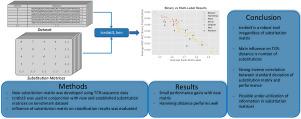Comparison of different substitution matrices for distance based T-cell receptor epitope predictions using tcrdist3
引用次数: 0
Abstract
Various methods, differing in complexity, have been developed to predict T-cell receptor epitopes. tcrdist3, which implements an easy-to-interpret distance-based approach, has demonstrated performance comparable to the best feature-based methods. Here, a new substitution matrix for tcrdist3 is proposed and its performance is compared to various other substitution matrices. Small performance gains were possible; however tcrdist3 was found to perform reliably well with most substitution matrices. Randomly generated substitution matrices were used as a baseline and resulted in good classification results. It was observed that the prediction quality was negatively correlated with the relative standard deviation of the matrix used (i.e. a larger variance of the weights resulted in poorer predictivity). The most important factor of the tcrdist3-distance between two sequences that could be singled out is the number of substitutions. tcrdist3 implicitly considers the number of substitutions and the type of substitution simultaneously. Using substitution matrices with larger variance penalizes certain substitutions more strongly, which blurs the clusters of sequences with the same number of substitutions. Since the number of substitutions was a key predictor, this resulted in decreased prediction performance.

使用tcrdist3进行基于距离的t细胞受体表位预测的不同替代矩阵的比较
各种方法,不同的复杂性,已经开发预测t细胞受体表位。Tcrdist3实现了一种易于解释的基于距离的方法,其性能可与最佳的基于特征的方法相媲美。本文提出了一种新的tcrdist3替换矩阵,并将其性能与其他替换矩阵进行了比较。小的性能提升是可能的;然而,我们发现tcrdist3在大多数替换矩阵中都表现得很好。随机生成的替代矩阵作为基线,得到了良好的分类结果。我们观察到,预测质量与所用矩阵的相对标准偏差呈负相关(即权重方差越大,预测能力越差)。两个序列之间的tcrdist3距离最重要的因素是替换的数量。Tcrdist3隐式地同时考虑替换的数量和替换的类型。使用方差较大的替换矩阵对某些替换的惩罚更强烈,这使得具有相同替换次数的序列簇变得模糊。由于替换次数是一个关键的预测因素,这将导致预测性能下降。
本文章由计算机程序翻译,如有差异,请以英文原文为准。
求助全文
约1分钟内获得全文
求助全文
来源期刊

Immunoinformatics (Amsterdam, Netherlands)
Immunology, Computer Science Applications
自引率
0.00%
发文量
0
审稿时长
60 days
 求助内容:
求助内容: 应助结果提醒方式:
应助结果提醒方式:


